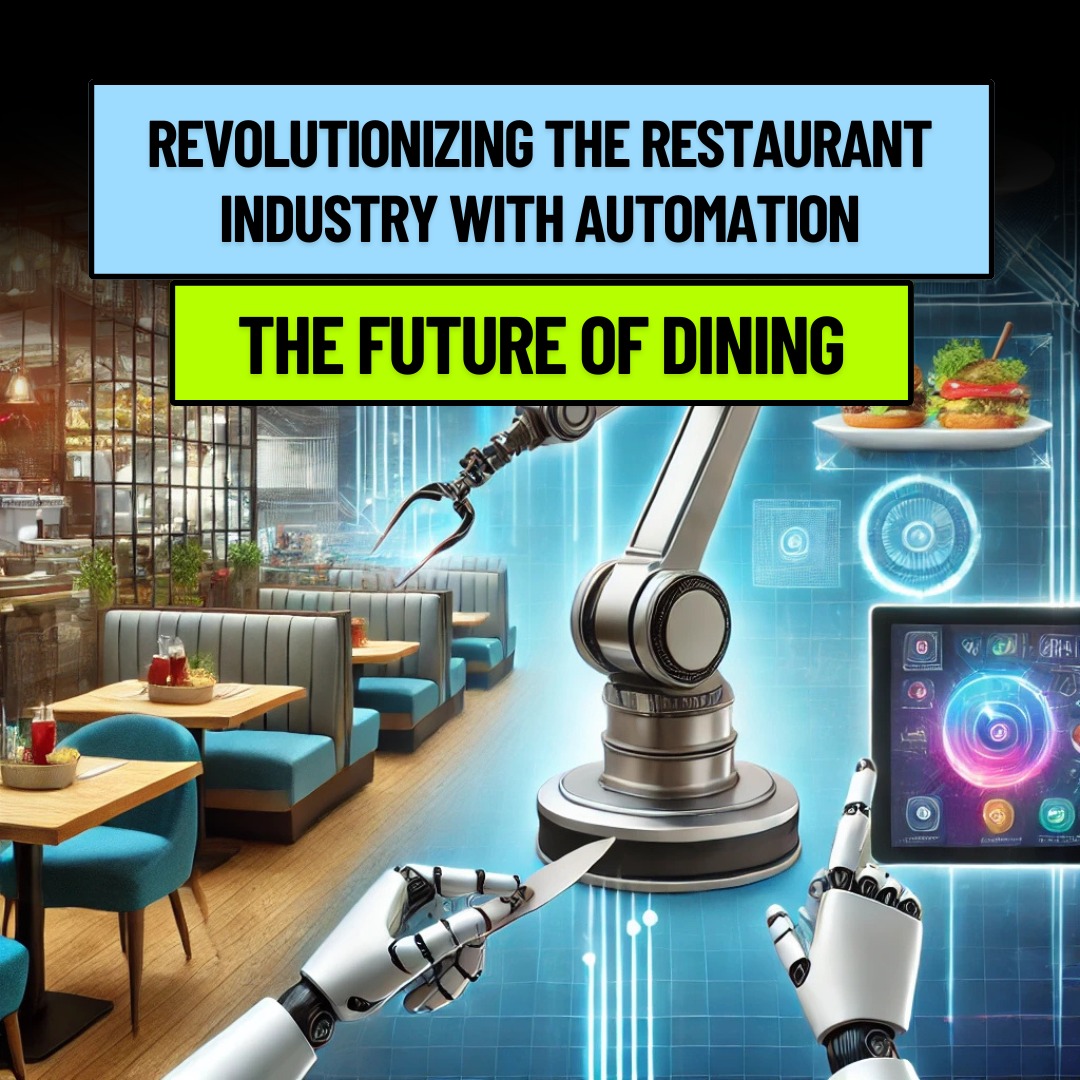ABSTRACT
The restaurant industry is undergoing a revolutionary transformation driven by automation and artificial intelligence (AI). This blog explores how cutting-edge technologies such as robotic chefs, self-service kiosks, and AI-driven inventory management are reshaping operations and enhancing customer experiences. By streamlining processes like order management, food preparation, and supply chain optimization, automation reduces costs, minimizes waste, and boosts efficiency. The blog highlights real-world success stories and the challenges of adopting these technologies, emphasizing their potential to redefine dining experiences. As the industry embraces automation, restaurants can achieve improved profitability, personalized services, and a competitive edge in a dynamic market.
INTRODUCTION
In an era where customer satisfaction and operational efficiency are paramount, the restaurant industry is undergoing a transformative shift. Automation is becoming the backbone of this transformation, enabling restaurants to streamline operations, reduce costs, and enhance the overall dining experience. The rise of artificial intelligence (AI), robotics, and machine learning has opened new doors for the industry, from inventory management to order fulfilment. As restaurants face the growing pressures of consumer demand, staff shortages, and the need for greater profitability, automation is emerging as a key solution. This article explores the profound impact of automation in the restaurant industry, highlighting its role in improving efficiency, reducing waste, and enhancing customer experience.
Know more about business automation-
THE RISE OF AUTOMATED FOOD SERVICES
The use of automation in food services began to take shape in the early 2020s and has been gaining traction ever since. As the restaurant industry strives to keep pace with evolving customer expectations, automation is becoming an essential tool for optimizing processes from food preparation to delivery. Robots are now performing tasks previously done by humans, such as cooking, serving, and even interacting with customers. The advent of automation technologies has brought significant improvements in speed, accuracy, and efficiency, all of which are vital for meeting the demands of modern diners.
Automation in restaurants is not just about replacing human labour; it’s about improving the overall dining experience for customers while boosting operational efficiency. From AI-powered order systems to robotic chefs, the use of technology is enhancing both the back-of-house operations and customer-facing services. The future of dining now includes self-order kiosks, automated cooking systems, and AI chatbots, all designed to provide quicker, more efficient, and personalized experiences.
INNOVATIVE TECHNOLOGY TRANSFORMING THE DINING INDUSTRY
The restaurant industry is increasingly adopting innovative technologies to enhance operations and meet customer demands. One of the most notable examples is the use of robotic kitchen systems, which have revolutionized food preparation. Companies like Miso Robotics have developed robots such as Flippy, a robotic arm designed to cook burgers with precision. Flippy can flip patties, apply condiments, and ensure that food is cooked to the perfect temperature every time, eliminating human error and improving consistency. This not only enhances food quality but also speeds up the cooking process, which is crucial for high-demand restaurants.
AI-driven menu engineering tools are transforming how restaurants design their offerings. These systems analyze customer preferences, sales data, and market trends to optimize menu pricing and layout. For example, AI tools can suggest which dishes are likely to be the most profitable or which items should be rotated off the menu. By using data analytics to make informed decisions, restaurants can maximize profits while keeping customers satisfied. Automation is also enhancing the customer experience. Self-service kiosks, for instance, allow customers to browse menus, customize their orders, and make payments without interacting with a cashier. This reduces wait times and improves the accuracy of orders. AI-powered loyalty programs track customer preferences and offer personalized discounts, fostering customer loyalty and increasing repeat business.
STREAMLINING OPERATIONS AND IMPROVING EFFICIENCY
Automation has proven to be a game-changer in improving operational efficiency. Inventory management is one area where automation is having a significant impact. Traditional inventory management methods, which involve manual stock-taking and ordering, are prone to human error and often lead to either overstocking or stockouts. Automated inventory systems, however, use real-time data to track inventory levels and automatically reorder supplies when stock is running low. These systems can also predict demand based on factors such as historical sales data, local events, and even weather conditions. By reducing waste and ensuring that ingredients are always available, automated inventory management helps restaurants maintain profitability and minimize food waste.
The use of AI-driven systems also helps optimize the supply chain, a vital component of restaurant operations. Automated ordering systems can track supplier performance, monitor price fluctuations, and suggest alternative suppliers if prices rise unexpectedly. These systems can also alert restaurant owners when supplies are running low, enabling them to place orders before running out of critical ingredients. By automating these processes, restaurants can improve their profit margins and maintain strong supplier relationships.
ENHANCING THE CUSTOMER EXPERIENCE THROUGH TECHNOLOGY
In addition to streamlining operations, automation is also improving the customer experience. The rise of self-order kiosks and mobile apps has significantly changed how customers interact with restaurants. Customers can now browse menus, place orders, and even pay for their meals without waiting in long lines or interacting with staff. This reduces wait times, minimizes human error, and gives customers greater control over their dining experience.
The integration of AI chatbots in customer service is another innovation that enhances the customer experience. Chatbots can handle routine tasks such as answering frequently asked questions, processing orders, and managing reservations. They can also provide personalized recommendations based on a customer’s past orders or preferences. This level of personalization not only improves customer satisfaction but also increases the likelihood of repeat business.
Robot waitstaff are becoming increasingly common in restaurants, further enhancing the customer experience. These robots are designed to take orders, serve food, and even engage with customers in a friendly manner. They are able to work tirelessly, never make mistakes, and always provide consistent service. This can reduce wait times, improve efficiency, and provide a unique experience for customers.
THE COST EFFICIENCY OF AUTOMATION
The initial investment required for automation systems can be high, but the long-term cost savings are significant. Robots, unlike human employees, do not require wages, benefits, or breaks. This makes them a cost-effective solution for tasks such as food preparation, order taking, and even cleaning. Robots can work around the clock, performing repetitive tasks with greater speed and accuracy than human workers.
Automation also helps reduce operational costs in other areas, such as waste management. AI-driven inventory systems predict demand with greater accuracy, ensuring that restaurants only order what they need, reducing excess food and preventing spoilage. This is particularly important in an industry where food waste can account for a significant portion of operating costs. By automating the ordering and inventory process, restaurants can reduce waste, improve profitability, and lower their environmental footprint.
Automated payment systems enable customers to pay quickly and securely, reducing the need for cashiers and improving the overall efficiency of the payment process. The integration of contactless payment systems further enhances the customer experience by allowing diners to pay without the need for physical interaction, which is especially important in the wake of the COVID-19 pandemic.
To know about business automation in food business, do check out this video-
REAL-WORLD EXAMPLES OF AUTOMATION IN ACTION
The benefits of automation in the restaurant industry are already being realized by many well-known brands. McDonald’s, for example, has implemented self-order kiosks in many of its locations, allowing customers to customize their orders and pay quickly. This has not only improved the speed and accuracy of service but also helped reduce labor costs. Similarly, Chipotle has been using AI-driven systems to optimize its menu and track customer preferences, resulting in increased sales and improved customer satisfaction.
White Castle has also embraced automation with the deployment of Flippy, a robotic kitchen assistant developed by Miso Robotics. Flippy is capable of flipping burgers, adding condiments, and ensuring that each burger is cooked to perfection. This has not only improved food consistency but also increased kitchen efficiency, allowing staff to focus on more complex tasks. Smaller establishments, such as pizzerias and cafes, are also seeing the benefits of automation. For example, a small pizza chain in New York reported a 20% reduction in waste and a 15% increase in profits after implementing an AI-driven inventory management system.
OVERCOMING CHALLENGES IN AUTOMATION ADOPTION
While automation offers numerous benefits, it also comes with its challenges. The initial cost of implementing automation technology can be a barrier, particularly for smaller restaurants. Additionally, integrating new technology into existing systems can be complex and may require staff training. However, as technology continues to evolve and become more affordable, the long-term benefits of automation—such as reduced labour costs, improved efficiency, and increased profitability—make it a worthwhile investment for many restaurants.
THE FUTURE OF RESTAURANT AUTOMATION
The future of restaurant automation is bright, with continued advancements in robotics, AI, and data analytics. The next generation of robotic kitchens promises to revolutionize food preparation, while AI-powered systems will further optimize customer service, inventory management, and supply chain operations. As these technologies continue to evolve, restaurants will increasingly rely on automation not only to improve efficiency but also to enhance the overall dining experience.
Restaurants that embrace automation today will be better positioned to compete in an increasingly competitive and fast-paced industry. By improving operational efficiency, reducing costs, and providing a better customer experience, automation is paving the way for the future of dining.
CONCLUSION
The rise of automation in the restaurant industry marks the beginning of a new era. From AI-driven order systems and robotic kitchens to self-service kiosks and automated payment systems, technology is transforming the way restaurants operate and interact with customers. As automation continues to evolve, it will play an even more significant role in enhancing operational efficiency, reducing costs, and improving the customer experience. For restaurant owners looking to stay competitive in a fast-changing market, embracing automation is no longer optional, it is essential.






